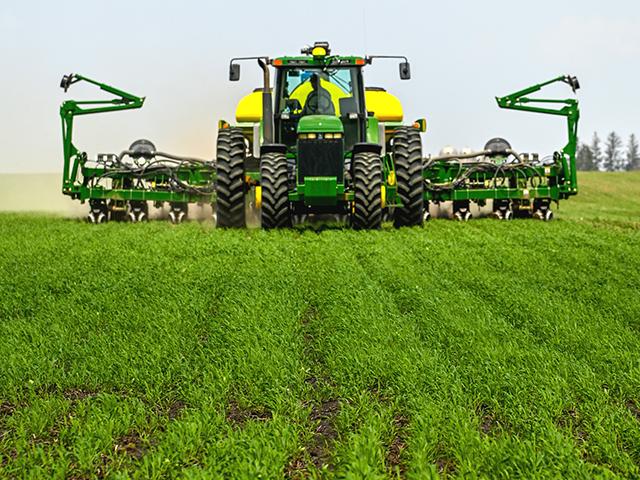Net Return Economic Simulator for Conservation Practice
Tool Calculates Cover Crop Returns
Wayne Fredericks pockets a little more than $39 and $17 per acre planting cover crops into corn and soybeans, respectively. That's in north-central Iowa, where many farmers don't think the conservation practice is economically viable or contend it can't work due to the climate and a shorter growing season, the Osage farmer says.
About 75 miles to the south, near Reinbeck, Iowa, Jack Boyer reports a similar net return from adding cover crops to his cropping system.
How can both farmers, who each plant cover crops on all their acres, say with confidence that the practice is profitable? The Iowa Soybean Association's (ISA) Cover Crop Net Return Economic Simulator says so.
Economics is one of the biggest stumbling blocks to cover crop adoption. Cover crop users say a yield reduction can occur during the first year or two of adoption as they fine-tune management. Then, there is the cost of the seed, planting and termination. But, as grower knowledge and soil conditions improve, so does the probability of a return on investment.
"Cover crops are probably one of the most difficult practices to take to the bank and tell them what my return is going to be," Fredericks says, noting that's no longer an obstacle. "It [simulator] shows economically how [cover crops] can help."
Boyer and Fredericks, both longtime cover croppers, are part of an advisory panel that helped ISA researchers develop and refine the calculator.
"I think it can be a valuable education tool," Boyer continues. "In my management style ... cover crops pay."
P[L1] D[0x0] M[300x250] OOP[F] ADUNIT[] T[]
WEATHER RESILIENCE
Planting cover crops such as cereal rye, annual rye, oats, hairy vetch and/or other plants just before or after harvest provides living, seasonal coverage of soil between commodity or forage crops. On-farm benefits include reduced soil erosion and compaction, higher organic matter, improved water infiltration and storage, greater weed and pest suppression, better nutrient cycling, less sediment runoff and more.
Boyer and Fredericks say their crops are less stressed in dry years compared to neighboring fields without cover crops. Ponding after heavy rains and wind erosion isn't a worry on their cover cropped acres, the farmers say. "I believe it's because my soil is more resilient," Boyer concludes.
Yet, cover crops are only planted on 15.4 million acres, or 3.9% of U.S. cropland, according to the 2017 U.S. Census of Agriculture.
The ISA created the simulator, which went live in late 2020, with the financial help of an Iowa Natural Resources Conservation Service Innovation Grant. The online tool fulfills multiple goals of the organization, says ISA data analyst Suzanne Fey.
By showing the financial potential of cover crops, that could boost adoption, Fey explains. In turn, that can ensure the long-term sustainability and competitiveness of Iowa soybean farmers. However, farmers nationwide can use the free tool and benefit since individual data is used.
"What we're trying to do is help farmers find ways to make it [cover crops] work," she says.
COVER CROPS PAY
When using the simulator to calculate the net return of corn after cover crops, Fredericks conservatively uses an average yield of 200 bushels per acre (bpa) (2021 yields averaged about 220 bpa) and a $5-per-bushel selling price. His estimated cost to buy and plant cereal rye is $26.71 per acre (includes a $10-per-acre reduction in herbicide costs). The mitigation value totals $65.76 per acre, which includes reduced commercial fertilizer needs at $38.74 per acre; reduced insurance requirement at $10.50 per acre (cheaper countywide protection is chosen instead of more expensive revenue protection because of soil resilience); improved water retention at $5 per acre; reduced erosion at $1.52 per acre; and crop insurance discount at $10 per acre.
Fredericks says the calculator "puts a different look at cover crops than anyone is used to seeing."
Building organic matter by 1% and reducing nitrogen needs by 40% are two of the big benefits of cover crops on Boyer's farm. "If you go buy a piece of property, you know that you're willing to give more money for one with higher organic matter. So, you know there's value there," he concludes.
**
FOR MORE INFORMATION:
-- Find the Iowa Soybean Association's cover crop calculator at https://analytics.iasoybeans.com/…
-- Follow the latest from Matthew Wilde, Crops Editor, by visiting the Production Blogs at https://www.dtnpf.com/… or following him on Twitter @progressivwilde
[PF_1222]
(c) Copyright 2022 DTN, LLC. All rights reserved.




